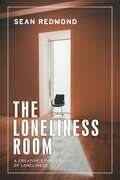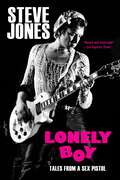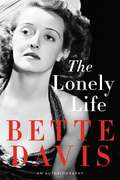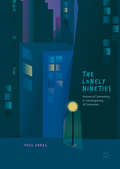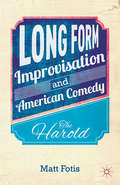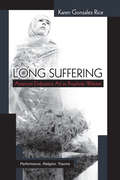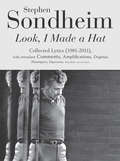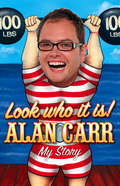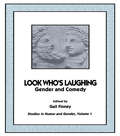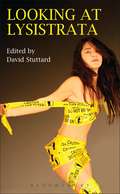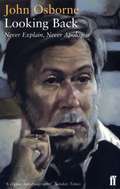- Table View
- List View
London on Film
by Pam Hirsch Chris O'RourkeThis book, a collection of essays by expert film researchers and lecturers, contributes to the growing body of scholarship on cinematic cities by looking at how one city—London—has been represented on film. In particular, the collection examines how films about London have responded to social, material and political change in the city, either by capturing and so influencing how we think about London, or by acting as catalysts (intentionally or otherwise) for public debate. Individual essays explore films ranging from the earliest actualities of the late nineteenth century to contemporary blockbusters. The book will appeal to film scholars and students, as well as to readers interested in the history of London and its changing image.
London on Film
by Pam Hirsch Chris O'RourkeThis book, a collection of essays by expert film researchers and lecturers, contributes to the growing body of scholarship on cinematic cities by looking at how one city—London—has been represented on film. In particular, the collection examines how films about London have responded to social, material and political change in the city, either by capturing and so influencing how we think about London, or by acting as catalysts (intentionally or otherwise) for public debate. Individual essays explore films ranging from the earliest actualities of the late nineteenth century to contemporary blockbusters. The book will appeal to film scholars and students, as well as to readers interested in the history of London and its changing image.
London on Film
by Pam Hirsch Chris O'RourkeThis book, a collection of essays by expert film researchers and lecturers, contributes to the growing body of scholarship on cinematic cities by looking at how one city—London—has been represented on film. In particular, the collection examines how films about London have responded to social, material and political change in the city, either by capturing and so influencing how we think about London, or by acting as catalysts (intentionally or otherwise) for public debate. Individual essays explore films ranging from the earliest actualities of the late nineteenth century to contemporary blockbusters. The book will appeal to film scholars and students, as well as to readers interested in the history of London and its changing image.
London on Film
by Pam Hirsch Chris O'RourkeThis book, a collection of essays by expert film researchers and lecturers, contributes to the growing body of scholarship on cinematic cities by looking at how one city—London—has been represented on film. In particular, the collection examines how films about London have responded to social, material and political change in the city, either by capturing and so influencing how we think about London, or by acting as catalysts (intentionally or otherwise) for public debate. Individual essays explore films ranging from the earliest actualities of the late nineteenth century to contemporary blockbusters. The book will appeal to film scholars and students, as well as to readers interested in the history of London and its changing image.
The loneliness room: A creative ethnography of loneliness (Anthropology, Creative Practice and Ethnography)
by Sean RedmondThis remarkably unique book takes the conceit of the loneliness room to show how everyday artistic practice opens up loneliness to new definitions and new understandings. Refusing to pathologise loneliness, the book draws on the creative submissions supplied by its participants to demonstrate that being lonely can mean different things to different people in differing contexts. Filled with the photographs, paintings, videos, songs, and writings of its participants, The loneliness room is a deeply moving account of loneliness today.https://sredmond4.wixsite.com/lonelyroom
The loneliness room: A creative ethnography of loneliness (Anthropology, Creative Practice and Ethnography)
by Sean RedmondThis remarkably unique book takes the conceit of the loneliness room to show how everyday artistic practice opens up loneliness to new definitions and new understandings. Refusing to pathologise loneliness, the book draws on the creative submissions supplied by its participants to demonstrate that being lonely can mean different things to different people in differing contexts. Filled with the photographs, paintings, videos, songs, and writings of its participants, The loneliness room is a deeply moving account of loneliness today.https://sredmond4.wixsite.com/lonelyroom
Lonely Boy: Tales from a Sex Pistol
by Steve JonesWithout the Sex Pistols there would be no punk. And without Steve Jones there would be no Sex Pistols. It was Steve who, with his schoolmate Paul Cook, formed the band that eventually went on to become the Sex Pistols and who was its original leader. As the world celebrates the 40th anniversary of punk--the influence and cultural significance of which is felt in music, fashion, and the visual arts to this day--Steve tells his story for the very first time.Steve Jones's modern Dickensian tale began in the street of Hammersmith and Shepherd's Bush, West London, where as a lonely, neglected boy living off his wits and petty thievery he was given purpose by the glam art rock of David Bowie and Roxy Music. He became one of the first generation of ragamuffin punks taken under the wings of Malcolm McLaren and Vivienne Westwood.In Lonely Boy, Steve describes the sadness of never having known his real dad, the abuse he suffered at the hands of his stepfather, and how his interest in music and fashion saved him from a potential life of crime spent in remand centers and prisons. He takes readers on his journey from the Kings Road of the early '70s through the years of the Sex Pistols, punk rock, and the recording of "Anarchy in the UK" and Never Mind the Bollocks. He recounts his infamous confrontation on Bill Grundy's Today program--the interview that ushered in the "Filth and the Fury" headlines that catapulted punk into the national consciousness. And he delves into the details of his self-imposed exile in New York and Los Angeles, where he battled alcohol, heroin, and sex addiction but eventually emerged to gain fresh acclaim as an actor and radio host.Lonely Boy is the story of an unlikely guitar hero who, with the Sex Pistols, transformed twentieth-century culture and kick-started a social revolution.
The Lonely Life: An Autobiography
by Bette DavisOriginally published in 1962, The Lonely Life is legendary silver screen actress Bette Davis's lively and riveting account of her life, loves, and marriages--now in ebook for the first time, and updated with an afterword she wrote just before her death. As Davis says in the opening lines of her classic memoir: "I have always been driven by some distant music--a battle hymn, no doubt--for I have been at war from the beginning. I rode into the field with sword gleaming and standard flying. I was going to conquer the world." A bold, unapologetic book by a unique and formidable woman, The Lonely Life details the first fifty-plus years of Davis's life--her Yankee childhood, her rise to stardom in Hollywood, the birth of her beloved children, and the uncompromising choices she made along the way to succeed. The book was updated with new material in the 1980s, bringing the story up to the end of Davis's life--all the heartbreak, all the drama, and all the love she experienced at every stage of her extraordinary life. The Lonely Life proves conclusively that the legendary image of Bette Davis is not a fable but a marvelous reality.
The Lonely Nineties: Visions Of Community In Contemporary Us Television
by Paul ArrasThis book examines the most popular American television shows of the nineties—a decade at the last gasp of network television’s cultural dominance. At a time when American culture seemed increasingly fragmented, television still offered something close to a site of national consensus. The Lonely Nineties focuses on a different set of popular nineties television shows in each chapter and provides an in-depth reading of scenes, characters or episodes that articulate the overarching “ideology” of each series. It ultimately argues that television shows such as Seinfeld, Friends, Law & Order and The Simpsons helped to shape the ways Americans thought about themselves in relation to their friends, families, localities, and nation. It demonstrates how these shows engaged with a variety of problems in American civic life, responded to the social isolation of the age, and occasionally imagined improvements for community in America.
The Lonely Nineties (PDF)
by Paul ArrasThis book examines the most popular American television shows of the nineties—a decade at the last gasp of network television’s cultural dominance. At a time when American culture seemed increasingly fragmented, television still offered something close to a site of national consensus. The Lonely Nineties focuses on a different set of popular nineties television shows in each chapter and provides an in-depth reading of scenes, characters or episodes that articulate the overarching “ideology” of each series. It ultimately argues that television shows such as Seinfeld, Friends, Law & Order and The Simpsons helped to shape the ways Americans thought about themselves in relation to their friends, families, localities, and nation. It demonstrates how these shows engaged with a variety of problems in American civic life, responded to the social isolation of the age, and occasionally imagined improvements for community in America.
Long Day's Journey Into Night
by Eugene O'NeillLong Day's Journey into Night was written in 1940 but not staged until 1956, after O'Neill's death. Unashamedly autobiographical, it is, as he puts it himself in the dedicatory note, 'a play of old sorrow, written in tears and blood', a harrowing attempt to understand himself and his family.
Long Form Improvisation and American Comedy: The Harold
by M. FotisLong form scenic improv began with the Harold. The comic philosophy of this form started an era of comedy marked by support, trust, and collaboration. This book tells of the Harold, beginning with the development of improv theatre, through the tensions and evolutions that led to its creation at iO, and to its use in contemporary filmmaking.
A Long Hard Look at 'Psycho' (BFI Silver)
by Raymond DurgnatUpon its release in 1960, Alfred Hitchcock's Psycho divided critical opinion, with several leading film critics condemning Hitchcock's apparent encouragement of the audience's identification with the gruesome murder that lies at the heart of the film. Such antipathy did little to harm Psycho's box-office returns, and it would go on to be acknowledged as one of the greatest film thrillers, with scenes and characters that are among the most iconic in all cinema. In his illuminating study of Psycho, Raymond Durgnat provides a minute analysis of its unfolding narrative, enabling us to consider what happens to the viewer as he or she watches the film, and to think afresh about questions of spectatorship, Hollywood narrative codes, psycho-analysis, editing and shot composition.In his introduction to the new edition, Henry K. Miller presents A Long Hard Look at 'Psycho' as the culmination of Durgnat's decades-long campaign to correct what he called film studies' 'Grand Error'. In the course of expounding Durgnat's root-and-branch challenge to our inherited shibboleths about Hollywood cinema in general and Hitchcock in particular, Miller also describes the eclectic intellectual tradition to which Durgnat claimed allegiance. This band of amis inconnus, among them William Empson, Edgar Morin and Manny Farber, had at its head Durgnat's mentor Thorold Dickinson. The book's story begins in the early 1960s, when Dickinson made the long hard look the basis of his pioneering film course at the Slade School of Fine Art, and Psycho became one of its first objects.
A Long, Long Way: Hollywood's Unfinished Journey from Racism to Reconciliation
by Greg GarrettFrom the beginning, American cinema has been both a powerful mythmaker and a social critic. D.W. Griffith's Birth of a Nation, arguably the first feature film, shows us just how early in its history cinema had established its influence. In 1915 it was the first movie to be screened at the White House. After the screening, President Woodrow Wilson is rumored to have said, "It's like history writ with lightning. And my only regret is that it is all terribly true." Birth of a Nation famously portrayed the Klu Klux Klan in a favorable light, a portrayal that contributed to the modern resurgence of the group and brought racist depictions of African Americans imported from the minstrel show to the silver screen. Such white fantasies of black American life have played out on our movie screens for the last century. In response, filmmakers of color have created nuanced and indelible portraits of race, as in Ava DuVernay's Selma or Barry Jenkin's Moonlight. Spike Lee's BlacKkKlansman shows us just how far into our culture Birth of a Nation has reached. In this powerful new book, Greg Garrett brings his signature brand of theologically motivated cultural criticism to bear on this history. After more than a century of cinema, he argues, movies have altered our cultural perspectives in the same way that religious narratives have. And in fact, religious traditions offer powerful correctives to our cultural narratives. A Long, Long Way incorporates both cinematic and religious truth-telling to the subject of race and reconciliation. In acknowledging the racist history of America's national art form, Garrett offers the possibility of hope for the future.
A Long, Long Way: Hollywood's Unfinished Journey from Racism to Reconciliation
by Greg GarrettFrom the beginning, American cinema has been both a powerful mythmaker and a social critic. D.W. Griffith's Birth of a Nation, arguably the first feature film, shows us just how early in its history cinema had established its influence. In 1915 it was the first movie to be screened at the White House. After the screening, President Woodrow Wilson is rumored to have said, "It's like history writ with lightning. And my only regret is that it is all terribly true." Birth of a Nation famously portrayed the Klu Klux Klan in a favorable light, a portrayal that contributed to the modern resurgence of the group and brought racist depictions of African Americans imported from the minstrel show to the silver screen. Such white fantasies of black American life have played out on our movie screens for the last century. In response, filmmakers of color have created nuanced and indelible portraits of race, as in Ava DuVernay's Selma or Barry Jenkin's Moonlight. Spike Lee's BlacKkKlansman shows us just how far into our culture Birth of a Nation has reached. In this powerful new book, Greg Garrett brings his signature brand of theologically motivated cultural criticism to bear on this history. After more than a century of cinema, he argues, movies have altered our cultural perspectives in the same way that religious narratives have. And in fact, religious traditions offer powerful correctives to our cultural narratives. A Long, Long Way incorporates both cinematic and religious truth-telling to the subject of race and reconciliation. In acknowledging the racist history of America's national art form, Garrett offers the possibility of hope for the future.
Long Lost Family: True stories of families reunited
by Humphrey PriceHosted by Davina McCall and Nicky Campbell, Long Lost Family has been a huge ratings success for ITV1 during the Spring of 2011, winning huge audiences of between 4.5 and 5 million during its 6-part run in April and May 2011. The programme was instantly re-commissioned, and Series 2 is due to be broadcast in Spring 2012. The show helps relatives - some of whom have been searching in vain for many years - to find the family members they are desperately seeking. It explores the background and context of each family's estrangement and reveals the detective work and complex and emotional process of finding each lost relative before they are reunited. It is tear-jerking stuff. This brilliant new book takes the very best emotional stories from the show and expands on them to tell these wonderfully warm and poignant tales in all their heartstring-tugging glory. It also contains a section of hints and tips for how to go about starting a search for a long lost family member. The perfect gift for Mother's Day.
Long Suffering: American Endurance Art as Prophetic Witness (Theater: Theory/Text/Performance)
by Karen Gonzalez RiceLong Suffering productively links avant-garde performance practices with religious histories in the United States, setting contemporary performances of endurance art within a broader context of prophetic religious discourse in the United States. Its focus is on the work of Ron Athey, Linda Montano, and John Duncan, American artists whose performances involve extended periods of suffering. These unsettling performances can disturb, shock, or frighten audiences, leaving them unsure how to respond. The book examines how these artists work at the limits of the personal and the interpersonal, inflicting suffering on themselves and others, transforming audiences into witnesses, straining social relations, and challenging definitions of art and of ethics. By performing the death of self at the heart of trauma, strategies of endurance signal artists’ attempts to visualize, legitimize, and testify to the persistent experience of being wounded. The artworks discussed find their foundations in artists’ early experiences of religion and connections with the work of reformers from Angelina Grimké to Rev. Martin Luther King, Jr., who also used suffering as a strategy to highlight social injustice and call for ethical, social, and political renewal.
The Long Take: Critical Approaches (PDF) (Palgrave Close Readings in Film and Television)
by John Gibbs Douglas PyeThis is the first book in English exclusively devoted to the long take, one of the key elements of film style. Increasingly visible in contemporary international media, the long take currently attracts a good deal of attention in criticism and commentary. There are also significant strands of film theory in which duration has become a recurrent concern. In keeping with the approach of Palgrave Close Readings in Film and Television, this collection is devoted to the detailed critical analysis of specific long takes, explored in terms of how they function within their contexts, how they shape the visual field, the meanings they generate and the effects they create. The Long Take: Critical Approaches brings together essays by established and emerging scholars (all but one essay commissioned for this volume) in an exciting collection that analyses works from a range of filmmaking traditions, from the 1930s to the present day, selected to represent varied long take practices and to explore associated debates.
Look, I Made a Hat: Collected Lyrics (1981-2011) with attendant Comments, Amplifications, Dogmas, Harangues, Digressions, Anecdotes and Miscellany
by Stephen SondheimAs he did in the acclaimed Finishing the Hat, Sondheim richly annotates his lyrics with personal and theatre history, discussions of his collaborations, and exacting, charming dissections of his work - both the successes and the failures. Picking up where he left off in Finishing the Hat, he gives us all the lyrics, along with cutouts and early drafts, to the Pulitzer Prize-winning Sunday in the Park with George, as well as Into the Woods, Assassins, and Passion. Here too is an in-depth look at Wise Guys, subsequently transformed into Bounce, and eventually into Road Show. And we are treated to chapters on his work for television and film and his "orphan songs," culled from parodies and special occasions over the years. Filled with behind-the-scenes photographs and illustrations from original manuscripts, and with the same elegant design as the earlier book, Look, I Made A Hat will be devoured by Sondheim's passionate fans today and for years to come.
Look who it is!: My Story
by Alan CarrThe brilliantly funny and inimitable Alan Carr tells his life story in his own words, from growing up in a football-mad family in Northampton to his rise to become one of Britain’s best-loved comedians.
Look Who's Laugh:Stud/Gender/C
by FinneyFirst Published in 1994. Routledge is an imprint of Taylor & Francis, an informa company.
Look Who's Laugh:Stud/Gender/C
by FinneyFirst Published in 1994. Routledge is an imprint of Taylor & Francis, an informa company.
Looking at Lysistrata: Eight Essays and a New Version of Aristophanes' Provocative Comedy
by David StuttardIn Aristophanes' Lysistrata, the women of Athens, fed up with the war against Sparta, go on a sex strike and barricade themselves into the acropolis to persuade their husbands to vote against the war. It is the most often performed of all Aristophanes' comedies. It is also, perhaps, the most misunderstood. This collection of essays by eight leading academics - written for sixth-form students and the general public alike - sets the play firmly in its historical and social context, while exploring Aristophanes' purpose in writing it and considering the responses of modern audiences and directors. The collection has been assembled and edited by David Stuttard, whose energetic new performing version of the play is included in this volume. Contributors include: Alan Beale; Edith Hall; Lorna Hardwick; James Morwood; Martin Revermann; James Robson; Alan H. Sommerstein; Michael Walton.
Looking at Lysistrata: Eight Essays and a New Version of Aristophanes' Provocative Comedy
by David StuttardIn Aristophanes' Lysistrata, the women of Athens, fed up with the war against Sparta, go on a sex strike and barricade themselves into the acropolis to persuade their husbands to vote against the war. It is the most often performed of all Aristophanes' comedies. It is also, perhaps, the most misunderstood. This collection of essays by eight leading academics - written for sixth-form students and the general public alike - sets the play firmly in its historical and social context, while exploring Aristophanes' purpose in writing it and considering the responses of modern audiences and directors. The collection has been assembled and edited by David Stuttard, whose energetic new performing version of the play is included in this volume. Contributors include: Alan Beale; Edith Hall; Lorna Hardwick; James Morwood; Martin Revermann; James Robson; Alan H. Sommerstein; Michael Walton.
Looking Back: Look Back In Anger; Epitaph For George Dillon; The World Of Paul Slickey; Dejavu (Faber Drama Ser. #Vol. 9)
by John OsborneWhen John Osborne died at Christmas 1994, his obituaries cited his autobiographical writings as perfect examples of undiluted talent and acerbic wit. Now, Osborne's superb autobiographies, A Better Class of Person: 1929-1956 and Almost a Gentleman: 1955-1966 (winner of the J. R. Ackerley Prize), are available for the first time in one volume, Looking Back.'A brilliant, funny, melancholy and acrimonious book of memoirs . . . Almost every page confirms that his powers as an elegist, definer of the Zeitgeist and master of unforgiving disgust remain undimmed.' ObserverThis volume also contains 'Bad John', a review by Alan Bennett of A Better Class of Person, and David Hare's eulogy for John Osborne at the memorial service for Osborne in 1995.

